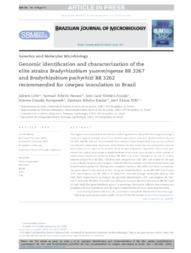Genomic identification and characterization of the elite strains Bradyrhizobium yuanmingense BR 3267 and Bradyrhizobium pachyrhizi BR 3262 recommended for cowpea inoculation in Brazil.
Genomic identification and characterization of the elite strains Bradyrhizobium yuanmingense BR 3267 and Bradyrhizobium pachyrhizi BR 3262 recommended for cowpea inoculation in Brazil.
Author(s): LEITE, J.; PASSOS, S. R.; ARAUJO, J. L. S. de; RUMJANEK, N. G.; XAVIER, G. R.; ZILLI, J. E.
Summary: The leguminous inoculation with nodule-inducing bacteria that perform biological nitrogenfixation is a good example of an ?eco-friendly agricultural practice?. Bradyrhizobium strainsBR 3267 and BR 3262 are recommended for cowpea (Vigna unguiculata) inoculation in Braziland showed remarkable responses; nevertheless neither strain was characterized at specieslevel, which is our goal in the present work using a polyphasic approach. The strains pre-sented the typical phenotype of Bradyrhizobium with a slow growth and a white colony onyeast extract-mannitol medium. Strain BR 3267 was more versatile in its use of carbonsources compared to BR 3262. The fatty acid composition of BR 3267 was similar to the typestrain of Bradyrhizobium yuanmingense; while BR 3262 was similar to Bradyrhizobium elkanii andBradyrhizobium pachyrhizi. Phylogenetic analyses based on 16S rRNA and three housekeep-ing genes placed both strains within the genus Bradyrhizobium: strain BR 3267 was closestto B. yuanmingense and BR 3262 to B. pachyrhizi. Genome average nucleotide identity andDNA?DNA reassociation confirmed the genomic identification of B. yuanmingense BR 3267and B. pachyrhizi BR 3262. The nodC and nifH gene analyses showed that strains BR 3267 andBR 3262 hold divergent symbiotic genes. In summary, the results indicate that cowpea canestablish effective symbiosis with divergent bradyrhizobia isolated from Brazilian soils.Published by Elsevier Editora Ltda. on behalf of Sociedade Brasileira de Microbiologia
Publication year: 2018
Types of publication: Journal article
Unit: Embrapa Agrobiology
Keywords: Rhizobia, Vigna Unguiculata
Observation
Some of Embrapa's publications are published as ePub files. To read them, use or download one of the following free software options to your computer or mobile device. Android: Google Play Books; IOS: iBooks; Windows and Linux: Calibre.
Access other publications
Access the Agricultural Research Database (BDPA) to consult Embrapa's full library collection and records.
Visit Embrapa Bookstore to purchase books and other publications sold by Embrapa.

